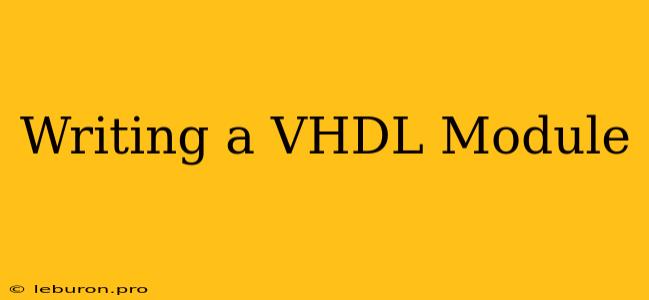Writing a VHDL module is a fundamental step in designing digital circuits using Hardware Description Languages (HDLs). VHDL, short for Very high-speed integrated circuit Hardware Description Language, allows engineers to describe the behavior and structure of digital circuits in a textual format that can be understood by synthesis tools to generate hardware. This article will guide you through the process of writing a VHDL module, covering the essential elements and considerations involved.
The Anatomy of a VHDL Module
A VHDL module, also known as an entity, serves as a blueprint for a specific digital circuit. It encapsulates the functionality and interface of the circuit. Here's a breakdown of the key components:
1. Entity Declaration: Defining the Interface
The entity declaration defines the input and output signals of the module, establishing the communication points between the module and the external world. This section declares the module's name and its ports.
entity my_module is
port (
input_signal : in std_logic; -- Input signal declaration
output_signal : out std_logic -- Output signal declaration
);
end entity my_module;
Explanation:
entity my_module is: This line declares the entity namedmy_module.port (...): This section defines the module's ports, which are the interface points.input_signal : in std_logic: This declares an input signal namedinput_signalof typestd_logic.output_signal : out std_logic: This declares an output signal namedoutput_signalof typestd_logic.
2. Architecture Body: Implementing the Logic
The architecture body is where the actual functionality of the module is defined. It describes the behavior of the circuit in terms of the declared input and output signals.
architecture behavioral of my_module is
begin
output_signal <= input_signal; -- Simple assignment statement
end architecture behavioral;
Explanation:
architecture behavioral of my_module is: This line declares the architecture namedbehavioralfor the entitymy_module.begin ... end architecture behavioral;: This defines the block of code where the logic is implemented.output_signal <= input_signal;: This is a simple assignment statement that assigns the value of the input signal to the output signal.
3. Signal Declarations: Internal Signals
Inside the architecture body, you can declare internal signals that are used for intermediate calculations or to simplify the module's logic.
architecture behavioral of my_module is
signal internal_signal : std_logic; -- Internal signal declaration
begin
internal_signal <= input_signal; -- Assign input to internal signal
output_signal <= internal_signal; -- Assign internal signal to output
end architecture behavioral;
Explanation:
signal internal_signal : std_logic;: This declares an internal signal namedinternal_signalof typestd_logic.- Internal signals are not accessible outside the module.
4. Processes: Sequential and Combinational Logic
VHDL offers processes as a way to define sequential and combinational logic. A process is a block of code that is executed when certain events occur, such as a change in input signals.
Sequential Logic:
architecture behavioral of my_module is
begin
process(input_signal) -- Sensitive to input signal changes
begin
if input_signal = '1' then
output_signal <= '1' after 10 ns; -- Delayed output
else
output_signal <= '0';
end if;
end process;
end architecture behavioral;
Combinational Logic:
architecture behavioral of my_module is
begin
process(input_signal) -- Sensitive to input signal changes
begin
output_signal <= input_signal xor '1'; -- XOR logic
end process;
end architecture behavioral;
5. Data Types: Representing Information
VHDL supports various data types to represent different types of information in your circuit. Some common data types include:
std_logic: Represents a single logic value (0, 1, 'X', 'Z', 'U', 'L', 'H', 'W').bit: Represents a single binary value (0 or 1).integer: Represents a signed integer.natural: Represents an unsigned integer.std_logic_vector: Represents a vector ofstd_logicvalues.
6. Operators: Performing Operations
VHDL offers various operators to perform operations on signals and data. These operators include:
- Arithmetic operators:
+,-,*,/,mod,rem. - Logical operators:
and,or,xor,not,nand,nor,xnor. - Relational operators:
=,/=(not equal),<,>,<=,>=. - Concatenation operator:
&.
7. Functions and Procedures: Reusable Code Blocks
Functions and procedures allow you to encapsulate reusable code blocks that can be called from different parts of your module.
Function:
function my_function(input_value : std_logic) return std_logic is
begin
if input_value = '1' then
return '0';
else
return '1';
end if;
end function my_function;
Procedure:
procedure my_procedure(input_value : inout std_logic) is
begin
input_value <= not input_value;
end procedure my_procedure;
Example: Writing a Simple VHDL Module
Let's illustrate the concepts with an example of a simple VHDL module that implements a 2-bit adder:
entity adder_2bit is
port (
a : in std_logic_vector(1 downto 0);
b : in std_logic_vector(1 downto 0);
sum : out std_logic_vector(1 downto 0);
carry : out std_logic
);
end entity adder_2bit;
architecture behavioral of adder_2bit is
begin
process(a, b)
begin
sum <= a + b;
carry <= '1' when a(1) = '1' and b(1) = '1' else '0';
end process;
end architecture behavioral;
Explanation:
- The entity
adder_2bithas two 2-bit input signalsaandb, a 2-bit output signalsum, and an output signalcarry. - The architecture
behavioraldescribes the functionality of the adder. - The process is sensitive to changes in
aandb. - The
sumis calculated by addingaandb. - The
carryis set to '1' if both the most significant bits ofaandbare '1', otherwise it's set to '0'.
Tips for Writing Effective VHDL Modules
- Use descriptive names for signals and entities. This makes your code easier to understand and maintain.
- Follow a consistent coding style. This enhances readability and reduces errors.
- Comment your code thoroughly. This helps to explain the functionality of your module.
- Test your modules thoroughly. Use simulation tools to verify the correctness of your code.
- Use libraries and packages. This provides access to predefined components and functions, simplifying your code.
Conclusion
Writing a VHDL module involves defining the module's interface, implementing the logic, and using appropriate data types and operators. Understanding the concepts outlined in this article will allow you to effectively create VHDL modules for your digital circuit designs. By following good coding practices and testing your modules rigorously, you can ensure the correctness and efficiency of your hardware designs.
